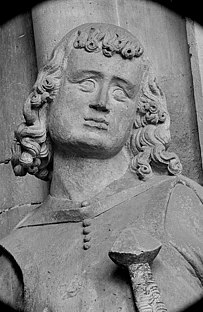
The Northern March or North March was created out of the division of the vast Marca Geronis in 965. It initially comprised the northern third of the Marca and was part of the territorial organisation of areas conquered from the Wends. A Lutician rebellion in 983 reversed German control over the region until the establishment of the March of Brandenburg by Albert the Bear in the 12th century.

The Margravate of Meissen was a medieval principality in the area of the modern German state of Saxony. It originally was a frontier march of the Holy Roman Empire, created out of the vast Marca Geronis in 965. Under the rule of the Wettin dynasty, the margravate finally merged with the former Duchy of Saxe-Wittenberg into the Saxon Electorate by 1423.
Bernard II was the Duke of Saxony between 1011 and 1059, the third of the Billung dynasty as a son of Bernard I and Hildegard. Besides his position in Saxony, he had the rights of a count in Frisia.

Conrad I, called the Great, a member of the House of Wettin, was Margrave of Meissen from 1123 and Margrave of Lusatia from 1136 until his retirement in 1156. Initially a Saxon count, he became the ruler over large Imperial estates in the Eastern March and progenitor of the Saxon electors and kings.
Dietrichof Haldensleben was a Saxon count in the Schwabengau, later also in the Nordthüringgau and the Derlingau, who was the first Margrave of the Northern March from 965 until the Great Slav Rising of 983. He also bore the title of a dux (duke) in contemporary sources.
Gero was the Archbishop of Magdeburg from 1012 until his death. He was a son of Dedo Wodenswege and Eilika (Eilica) and possibly a relative of the family of Gero the Great.

Herman I was Margrave of Meissen from 1009 until his death.
Lothair I was Margrave of the Nordmark from about 983 until his death. He was also a member of Saxon nobility as Count of Derlingau and of Nordthüringgau.
Werner was the Margrave of the Nordmark from 1003 until 1009. He was a cousin of the contemporary bishop and historian Thietmar of Merseburg.
Lothair Udo II was Margrave of the Nordmark from 1057 until his death and also Count of Stade. He was the only son of Lothair Udo I of the Udonids and Adelaide of Rheinfelden.
Theodoric II was Margrave of Lusatia from 1032 to 1034, the first of the Wettin dynasty.
Dedo I, Count of Wettin, also known as Dedo I of Wettin, was a son of Theodoric I of Wettin and Jutta of Merseburg.

Otto I, traditionally known as Otto the Great, was East Francian king from 936 and Holy Roman Emperor from 962 until his death in 973. He was the oldest son of Henry I the Fowler and Matilda.

The Counts of Walbeck ruled a medieval territory with its capital Walbeck northeast of Helmstedt in the present town Oebisfelde-Weferlingen in Saxony-Anhalt. The foundation of the Archbishopric of Magdeburg established the region as firmly in the oversight of Otto the Great, Holy Roman Emperor. The first Count of Walbeck, Lothar I, was great-grandfather of Thietmar, Prince-Bishop of Merseburg, chronicler of the Ottonian dynasty of Germany and the Holy Roman Empire. Two of Thietmar’s great-grandfathers, both named Lothar, were killed in the Battle of Lenzen, pitting the forces of Henry the Fowler against the Slavs. The early Margraves of the Nordmark were descended from the House of Walbeck.
Lothair Udo I, Margrave of Nordmark and Count of Stade, son of Siegfried II, Count of Stade, and Adela of Rhienfelden, daughter of Gero, Count of Alsleben. Lothair was the first of the House of Udonids to serve as margrave.
Helperich (Helferich), Count of Plötzkau and Walbeck, and Margrave of the Nordmark, son of Dietrich, Count of Plötzkau, and Mathilde von Walbeck, daughter of Conrad, Count of Walbeck, and Adelheid of Bavaria. The count's sister Irmgard was married to Lothair Udo III, Margrave of the Nordmark, and was the mother of Helperich's successor in ruling the margraviate, Henry II.
Udo IV, Margrave of the Nordmark and Count of Stade and Count of Freckleben, son of Rudolf I, Margrave of the Nordmark, and Richardis, daughter of Hermann von Sponheim, Burgrave of Magdeburg. It is unclear why he went by the abbreviated name of Udo as opposed the traditional Lothair Udo of his ancestors.
Friedrick, Count of Walbeck and Viscount (Burggraf) of Magdeburg, son of Siegfried I the Older, Count of Walbeck, and Kunigunde von Stade daughter of Henry I the Bald, Count of Stade. He was brother to Thietmar of Merseburg, whose Chronicon was the main source of information on him, and his predecessor Henry, Count of Walbeck.
Conrad (1018–1073), Count of Walbeck and Viscount (Burggraf) of Magdeburg, son of Friedrick, Count of Walbeck, and Thietburga. There is little known about Conrad's reign.
Gero, Count of Alsleben, conjectured to be the son of Siegfried and therefore grandson of Gero the Great. If so, his mother was Hedwig, daughter of Wichmann the Elder. Gero was the brother of Tetta, who established a monastery at Alsleben in his name. Thietmar of Merseburg, whose Chronicon is the major source of information here, refers to Gero as a Count in Northern Thuringia and Morzani.